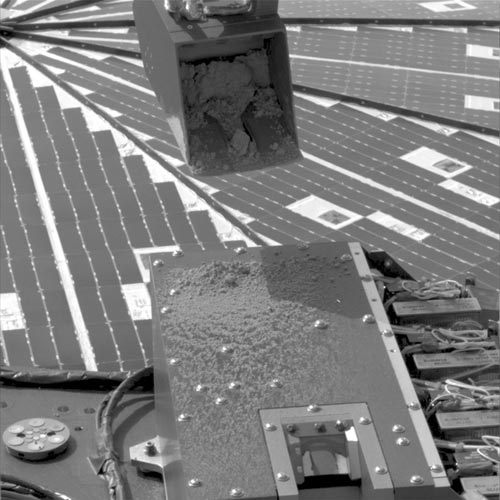Mars Soil Sample Finally Delivered to Phoenix Instrument

Scientistswere finally able to deliver a soil sample to an instrument aboard NASA'sPhoenix Mars Lander, after several frustrating days of failed attempts, missioncontrollers announced.
The welcomenews came on Wednesday morning, when Phoenixbeamed back the results of its activities from the previous day to scientistson Earth.
For thelast several days, scientists had tried to dislodge the clumpy soil sitting ontop of a screen that basically feeds samples into the ovens. The soil was stuckoutside the instrument's entrance. The solution was to run a vibrator on the Thermaland Evolved-Gas Analyzer (TEGA), which is designed to heat up the soilsamples to analyze their composition.
None of thedislodging attempts since the soil was first delivered on Saturday had beensuccessful, but scientists ranthe vibrator for a seventh (and likely final) time on Tuesday night "inthe off chance we might get lucky," said TEGA co-investigator WilliamBoynton of the University of Arizona.
"Thedirt finally did start to flow and we actually got a full oven, so that problemis now behind us," Boynton added. "We're hopeful that some time inthe next few days we'll close the oven and begin the analysis process."
WhenBoynton announced the unexpected result to the Phoenix team, "the groupjust went up into cheers," he said as he played the song "(Shake,Shake, Shake) Shake Your Booty."
TEGA's tinyovens will heat the samples up to progressively higher temperatures. The firstaim is to vaporize any ice that might be in the soil, which can be detected bythe instrument mass spectrometer. At higher temperatures, other minerals maydecompose into vapors as well, particularly any that formed in a wetenvironment.
Breaking space news, the latest updates on rocket launches, skywatching events and more!
"We'relooking for past interactions with water," Boynton explained.
Just whythe soil took such coaxing to get into TEGA is a mystery. The soil is unlikeanything scientists expected to encounter, said Phoenix principal investigatorPeter Smith, as it tends to clump together in little clods.
Scientistsaren't sure what in the soil is causing this clumpy behavior ? it could be aparticular mineral, or, some speculate, water ice (which is thought to formlayers just underneath the surface). Part of the reason ice is proposed ascausing the clumps is that the ice could have sublimed after spending severaldays out in the Martian sunshine, finally loosening the soil.
Scientistsgot the news about TEGA after Phoenix was sent its commands for its next day,so they will return to it in the coming days. Phoenix will spend its next dayon the red planet delivering a sample to its optical microscope.
After theproblems encountered with dumping the soil into TEGA, mission scientists havedevised a new method of sample delivery called "sprinkling."They will have the lander's robotic arm tilt its scoop, pushing the soil sampleto the front. They will then switch on the scoop's rasp to vibrate and loosensoil, causing some of it to fall out in the instrument.
"It'skind of a salt-shaker mode if you like," Smith said. "We've practicedthis before and we know it's going to work well."
"Deliveringthe soil is something we're getting better at everyday," Smith added.
The firstlook at a soil sample through the microscope should come on Thursday. Thisclose-up look at the soil should give scientists a better idea of just what isin the Martian regolith. Scientists back at the University of Arizona have been trying to mimic the sample in their lab, but "there's something missingin our mixtures here, and I'm quite anxious to find out what it is," Smithsaid.
- Video: Sounds From Phoenix Mars Lander's Descent
- Video: NASA's Phoenix: Rising to the Red Planet
- New Images: Phoenix on Mars!

Andrea Thompson is an associate editor at Scientific American, where she covers sustainability, energy and the environment. Prior to that, she was a senior writer covering climate science at Climate Central and a reporter and editor at Live Science, where she primarily covered Earth science and the environment. She holds a graduate degree in science health and environmental reporting from New York University, as well as a bachelor of science and and masters of science in atmospheric chemistry from the Georgia Institute of Technology.
